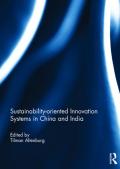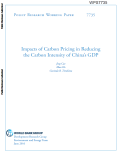The study is an in-depth analysis of carbon markets in China and presents a model to offer comprehensive inquiry. The model takes inputs – including policy interventions and certain assumptions like population trends, GDP growth and energy prices – and generates outputs related to investment required, policy-induced avoided costs and added benefits in areas like employment and performance against secondary targets related to energy consumption and emissions. It also includes several variables across sectors and thematic domains.
In addition to summarizing these data in a user-friendly presentation, the study includes original research insights revealing tangible policy, investment and business trends. This study provides the most comprehensive overview to date for market actors to better "connect the dots" between INDCs and their impacts on investment portfolios, business operations, and national policy making.
This report assesses why and how some countries within Asia (referred to in this report as Target Countries) have achieved success in attracting renewable energy investment, what are the critical barriers to furthering renewable energy deployment, and the policy measures and practical interventions that may help to overcome these barriers. The report also highlights how lower technology costs, increased competitiveness of renewable energy, and improved energy storage solutions are making the transition to renewable energy a reality and a priority.
Globally, new forms of electromobility are challenging established transport technologies based on internal combustion engines. The authors explore how this transition is simultaneously unfolding in four countries, enabling them to shed some light on the dynamics and determinants of technological path creation. The paper's analysis covers two old industrialized countries (France and Germany) and two newly industrialized countries (China and India) with very different market conditions and policy frameworks. It reveals enormously different choices of technologies and business models and traces them back to four main drivers of divergence: technological capabilities, demand conditions, political priorities and economic governance.

Transforming the world economy towards sustainability, while ensuring decent levels of resource use for all global citizens, is the greatest challenge of our time. This book explores how innovation systems need to be adapted to successfully confront these challenges. The first chapter introduces the concept of sustainability-oriented innovation systems which highlights the systematic differences between systems that have developed along current resource-intensive technological trajectories and those that address the impending environmental mega-problems. The subsequent articles present case studies of sustainability-oriented innovations in a number of policy areas, including energy efficiency, electric mobility and generation of renewable energy, in China and India. These case studies confirm the specificities of innovation systems geared towards a green techno-economic paradigm.

In contributing to global climate change mitigation efforts as agreed in Paris in 2015, China has set a target of reducing the carbon dioxide intensity of gross domestic product by 60-65 percent in 2030 compared with 2005 levels. Using a dynamic computable general equilibrium model of China, this study analyzes the economic and greenhouse gas impacts of meeting those targets through carbon pricing. The study finds that the trajectory of carbon prices to achieve the target depends on several factors, including how the carbon price changes over time and how carbon revenue is recycled to the economy. The study finds that carbon pricing that starts at a lower rate and gradually rises until it achieves the intensity target would be more efficient than a carbon price that remains constant over time. Using carbon revenue to cut existing distortionary taxes reduces the impact on the growth of gross domestic product relative to lump-sum redistribution. Recycling carbon revenue through subsidies to renewables and other low-carbon energy sources also can meet the targets, but the impact on the growth of gross domestic product is larger than with the other policies considered.
